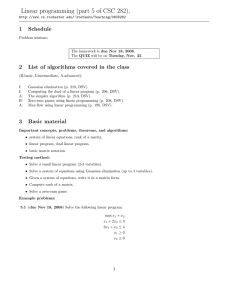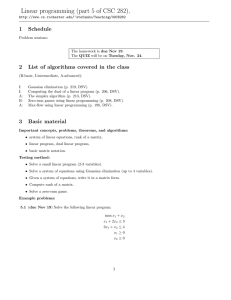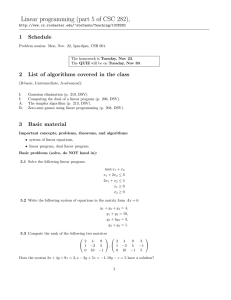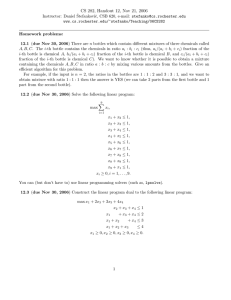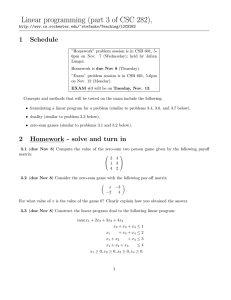Linear programming (part 5 of CSC 282), 1 Schedule
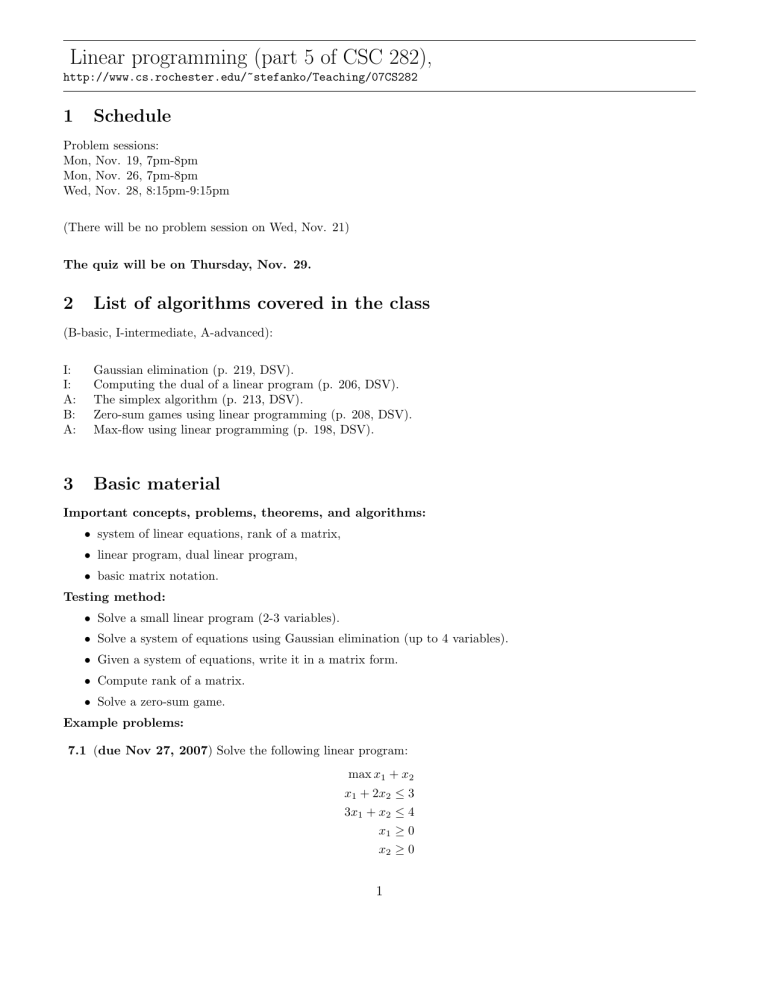
Linear programming (part 5 of CSC 282),
http://www.cs.rochester.edu/~stefanko/Teaching/07CS282
1 Schedule
Problem sessions:
Mon, Nov. 19, 7pm-8pm
Mon, Nov. 26, 7pm-8pm
Wed, Nov. 28, 8:15pm-9:15pm
(There will be no problem session on Wed, Nov. 21)
The quiz will be on Thursday, Nov. 29.
2 List of algorithms covered in the class
(B-basic, I-intermediate, A-advanced):
I: Gaussian elimination (p. 219, DSV).
I: Computing the dual of a linear program (p. 206, DSV).
A: The simplex algorithm (p. 213, DSV).
B: Zero-sum games using linear programming (p. 208, DSV).
A: Max-flow using linear programming (p. 198, DSV).
3 Basic material
Important concepts, problems, theorems, and algorithms:
• system of linear equations, rank of a matrix,
• linear program, dual linear program,
• basic matrix notation.
Testing method:
• Solve a small linear program (2-3 variables).
• Solve a system of equations using Gaussian elimination (up to 4 variables).
• Given a system of equations, write it in a matrix form.
• Compute rank of a matrix.
• Solve a zero-sum game.
Example problems:
7.1
( due Nov 27, 2007 ) Solve the following linear program: max x
1
+ x
2 x
1
+ 2 x
2
≤ 3
3 x
1
+ x
2
≤ 4 x
1
≥ 0 x
2
≥ 0
1
7.2
( due Nov 20, 2007 ) Solve the following system of equations using Gaussian elimination: y
1
+ y
2
+ y
4
= 4 , y
1
+ y
3
= 10 , y
3
+ 4 y
4
= 3 , y
2
+ y
4
= 1 .
7.3
( due Nov 20, 2007 ) Write the following system of equations in the matrix form Ax = b : y
1
+ y
2
+ y
4
= 4 , y
1
+ y
3
= 10 , y
3
+ 4 y
4
= 3 , y
2
+ y
4
= 1 .
7.4
( due Nov 20, 2007 ) Compute the rank of the following two matrices
2 4 9
1 − 3 5
0 10 − 1
,
2 4 9 3
1 − 3 5 − 1
0 10 − 1 5
Does the system 2 x + 4 y + 9 z = 3 , x − 3 y + 5 z = − 1 , 10 y − z = 5 have a solution?
7.5
( due Nov 20, 2007 ) Write the following system of equations in the matrix form Ax = b : y
1
+ y
2
+ y
4
= 4 , y
1
+ y
3
= 10 , y
3
+ 4 y
4
= 3 , y
2
+ y
4
= 1 .
4 Additional homework
7.6
( due Nov 27, 2007 ) [Problem rating: I.] Solve the following linear program: max
9
X x i
, i =1 x
1
+ x
2
≤ 1 , x
2
+ x
3
≤ 1 , x
3
+ x
4
≤ 1 , x
4
+ x
5
≤ 1 , x
5
+ x
6
≤ 1 , x
6
+ x
7
≤ 1 , x
7
+ x
8
≤ 1 , x
8
+ x
9
≤ 1 , x
9
+ x
1
≤ 1 , x i
≥ 0 , i = 1 , . . . , 9 .
Use a linear programming solver to obtain the solution (for example you can use freeware lpsolve or function
Maximize in Mathematica (installed in most labs)).
7.7
( due Nov 20, 2007 ) [Problem rating: I.] There are n bottles which contain different mixtures of three chemicals called A, B, C . The i -th bottle contains the chemicals in ratio a i
: b i
: c i
(thus, a i
/ ( a i
+ b i
+ c i
) fraction of the i -th
2
bottle is chemical A , b i
/ ( a i
+ b i
+ c i
) fraction of the i -th bottle is chemical B , and c i
/ ( a i
+ b i
+ c i
) fraction of the i -th bottle is chemical C ). We want to know whether it is possible to obtain a mixture containing the chemicals A, B, C in ratio a : b : c by mixing various amounts from the bottles. Give an efficient algorithm for this problem.
For example, if the input is n = 2, the ratios in the bottles are 1 : 1 : 2 and 3 : 3 : 1, and we want to obtain mixture with ratio 1 : 1 : 1 then the answer is YES (we can take 2 parts from the first bottle and 1 part from the second bottle).
7.8
( due Nov 27, 2007 ) [Problem rating: I.] Construct the linear program dual to the following linear program: max x
1
+ 2 x
2
+ 3 x
3
+ 4 x
4 x
2
+ x
3
+ x
4
≤ 1 x
1 x
1
+ x
2
+ x
3
+ x
4
≤ 2
+ x
4
≤ 3 x
1
+ x
2
+ x
3
≤ 4 x
1
≥ 0 , x
2
≥ 0 , x
3
≥ 0 , x
4
≥ 0 .
Find the optimal solution of the primal and the dual problem.
Use a linear programming solver to obtain the solutions.
5 Additional problems from the book (do not turn in)
Try to solve the following problems. A few of them will be on the quiz. We will go over the ones that you choose in the problem sessions.
• 7.1, 7.2, 7.3, 7.4, 7.7, 7.8, 7.11, 7.12, 7.13, 7.15, 7.19, 7.27.
3
